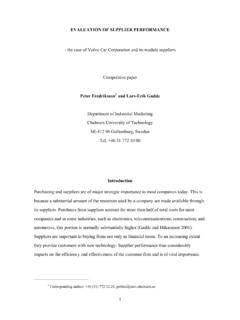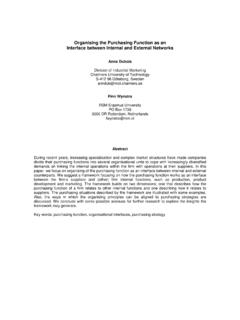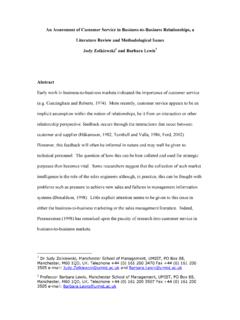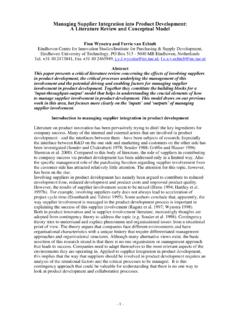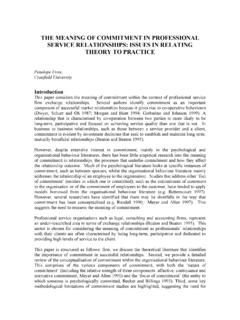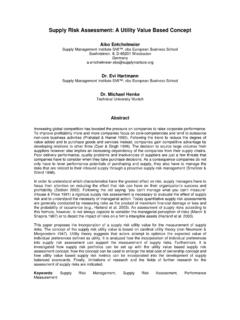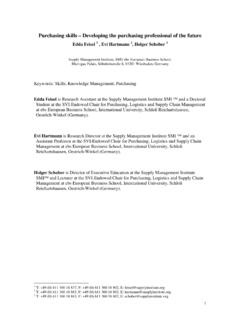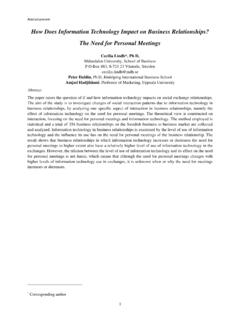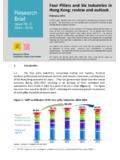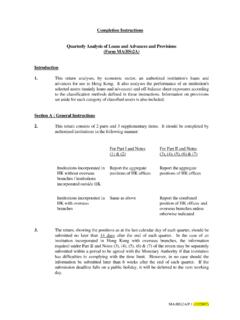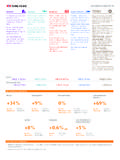Transcription of The impact of buyer-supplier relationship and …
1 1 The impact of buyer-supplier relationship and purchasing process on the supply chain performance : a conceptual framework Melody J. Hsiao University of Sydney Sharon Purchase University of Western Australia Shams Rahman University of Sydney ABSTRACT Supply chain performance is a rapidly developing area of research. Many companies are trying to find tools for enhancing performance measures in response to turbulent business markets and for efficiently controlling their business activities. Little empirical research has been conducted on the performance of retail supply chain in Taiwan and other Asian countries. Two factors affecting current retail supply chains, buyer-supplier relationships and purchasing processes, and their antecedents that are relevant to this unique cultural environment will be investigated. The objectives of this research are: (1) to identify the determinants affecting the performance of the supply chain at the retail level; (2) to define the antecedents related to each determinant; and (3) to present the conceptual model for this particular context.
2 This research will contribute by presenting a conceptual model for supply chain performance that is relevant to small and medium- sized businesses that predominate Taiwan. INTRODUCTION Supply chain management (SCM) is a key strategic factor for increasing organizational effectiveness and for better realization of organizational goals such as enhanced competitiveness, better customer care and increased profitability (Gunasekaran et al. 2001, p. 71). The major goals of SCM are to minimize non-value-added activities and associated investment cost and operating cost, increase customer responsiveness and flexibility in the supply chain, and enhance bottom-line performance and cost competitiveness (Stewart 1995). A recent study conducted by Petrovic-Lazarevic and Sohal (2002) reported that effective management of the supply chain has been identified as being of significant importance to achieving and sustaining a competitive advantage for firms in the Australian textiles, clothing, and footwear industry.
3 2 Many companies are trying to find tools for performance improvement in response to turbulent business markets and for efficiently controlling their business activities. The objectives of performance measurement are to improve the efficiency and effectiveness of a supply chain (Beamon 1999; Gunasekaran et al. 2001). In addition, Keeber (2000) also stated that the purpose of performance measurement is to reduce operating costs and customer service in logistics activities, improve firm s revenue growth, and enhance shareholder value. Sportswear is a globalised industry, with major production undertaken in Asian countries, and three international brands dominating worldwide sales Nike and Rebook from the US, and Adidas from Europe ( 2001). Moreover, sports superstars, TV sports programs and sports activities have great influence on this market. The sportswear market possesses the same characteristics as the fashion market: strong seasonality, short product life, volatile demand, and high impulse purchasing (Christopher and Peck 1997; Fisher et al.)
4 1994; Fisher et al. 2000). The seasons are affected not only by weather but also by the sporting calendar (Ashford 1997). The costs of stockout and markdown for big companies like Sport Obermeyer would be more than 10% of sales (Fisher et al. 1994). Thus, supply chain management in the sportswear market is critical to ensure that stock does not become out dated with the short product life cycle resulting in stockout and markdowns, thus reducing profits at the retail level. The reasons for conducting such a research in the context of Taiwan are: (1) Taiwan lies at an advantageous geographic location in the Asia-Pacific region, which is the hub position connected to Northeast Asia, Southeast Asia and coastal mainland China (Taiwan Headlines 31 January 2000), and it is why the government planned to develop Taiwan into a Global Logistics Center (CEPD 2001); (2) supply chain management is still in its infancy in Taiwan, especially in the retail sector (MOEA 1999); (3) increasing leisure time and sports activities have led to a growing demand for sports products, especially sportswear and sports related accessories ( Department of Commerce 1998).
5 (4) due to the popularity of big brands, such as Nike, Adidas and Reebok, many retailers needs to carry several brands on the shelves to attract more consumers shopping at their stores; and, (5) Taiwan s official accession to WTO in January 2002 has significant impact on market liberalization including tariff reduction in merchandise trade as well as more open domestic market for overseas investors (Hong Kong Trade Development Council November 2001). Total retail sales will reach from NT$ trillion in 2001 to NT$ trillion in 2010 (Civil Services of Doc 2001), which makes significant contribution to the strength of Taiwan s economy. The supply chain in Asia possesses special socio-economic characteristics such as a 3preponderance of small independent retailers with big international suppliers dominating the market. Current retail supply chains in Taiwan have the same phenomena.
6 Little empirical research has been conducted on supply chain performance at the retail level in Taiwan and other Asian countries. Therefore, the objectives of this paper are to; (1) identify the determinants affecting the performance of the supply chain at the retail level in Taiwan, (2) define the antecedents related to each determinant, and (3) present the conceptual model for this particular context. This paper will outline a conceptual development for the measurement of supply chain performance in Taiwan and illustrate a number of determinants that will affect performance . CONCEPTUAL MODEL The study of buyer-supplier relationships and purchasing process has been the central issue in relationship marketing and purchasing as well as business-to-business marketing literature. A brief review of the literature will be based on the hierarchical conceptual model (Figure 1), and details will be discussed with posited hypothesis in the next following section.
7 buyer-supplier relationships in the supply chain are one of the most important elements of supply chain integration. Establishing and managing effective relationships at every link in the supply chain is becoming the prerequisite of business success. High volatility in the retail industry reflects rapid fluctuations in customer demand and unpredictable market trends. In addition, environmental diversity reveals uncertainty in the global business environment. Facing market volatility and diversity, retailers are encouraged to develop relatively flexible relationships with multiple channel partners to deal with unexpected market demands and thus reduce the dependence on the vendor (Ganesan 1994). Several empirical studies conducted in China support that buyer-supplier relationships Supply Chain PerformanceBuyer- supplier RelationshipPurchasingProcessFigure 1: Conceptual ModelSupply Chain PerformanceBuyer- supplier RelationshipPurchasingProcessFigure 1: Conceptual Model 4have a positive effect on a firm s financial performance (Liu and Wang 2000; Luo 1997; Yeung and Tung 1996), or that manufacturer-distributor relationships and guanxi have an important impact on the performance of export ventures in China (Ambler et al.)
8 1999). Firms engaged in long-term relationship with their customers achieve higher profitability, and ROI than firms using a transactional approach (Kalwani and Narayandas 1995). Maloni and Benton (2000) found that strong buyer-supplier relationships have a significant positive effect on manufacturer performance , supplier performance , and performance of the entire supply chain. The study of buyer-supplier relationships and their impact on supply chain management is pertinent for two reasons. Firstly, the prevailing culture in Taiwan s distribution system emphasizes personal relationship between the manufacturers, wholesalers and retailers (Trappey and Lai 1996). Secondly, the Western literature of relational marketing or channel relationships may not fully explain the true essence of cross-cultural contextual factors (Mavondo and Rodrigo 2001). Thus, the cultural perspective in retailer- supplier relationships should be considered in deriving theoretical constructs.
9 On the other hand, both academics and practitioners have recognized that purchasing is key to a firm s competitive advantage, and that increased profitability, market share and technological innovation can be achieved through an appropriate purchasing strategy. A company s purchasing practices can impact the effectiveness of its SCM strategy and its financial and market performance (Tan et al. 1998). In current purchasing practice, orders from retailers are placed with the international suppliers many months ahead of the season, so the risk of both obsolescence and stock-outs is high. The lengthy pipeline increases inventory carrying cost and inefficiency in the supply chain. Besides, when it comes to the selling season, market demand may change and sales can be affected for various reasons such as economy, climate, consumer preference, sports events, unmatched supplies, etc.
10 (Fisher et al. 1994). buyer-supplier relationship Dimensions of buyer-supplier relationship As suggested by Olsen and Ellram (1997), the links between the characteristics of the relationship such as trust, cooperation, and the performance of the relationship need further research. Considering the key issues discussed earlier, five prominent dimensions of the buyer-supplier relationship : trust, communication, interpersonal relationship (guanxi), cooperation, and power-dependence, will be explored in the following discussions. Therefore, this study makes an important contribution to the relational 5literature and supply chain management literature through the investigation of the phenomena of retailer- supplier relationships and their impact on supply chains in the Chinese context. Trust Trust is a crucial factor in sustaining the complex business network and contributing to the success of a firm in Chinese business communities.
